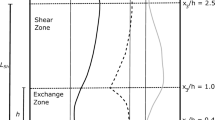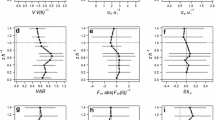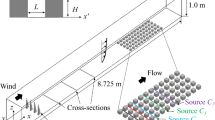Abstract
Eddy covariance data have been analyzed to examine intermittency and clustering properties of turbulence within open canopies. Intermittency consists of two aspects: one is related to amplitude variation and the other to clustering. Using the telegraph approximation (TA), the clustering properties have been separated from amplitude effects. Intermittency of canopy turbulence has been explored via clustering exponent, probability density distribution of inter-pulse period of TA, intermittency exponent and structure kurtosis. Intermittency and clustering properties of turbulence within open canopies show similar features to those within dense canopy but some differences are also noted. Unlike within a dense canopy, temperature does not show larger clustering than velocity, which seems to be due to a different thermal structure of the sub-canopy and larger vertical scale of canopy eddy within open canopies. Within the crown region, the inter-pulse probability distribution of TA does not show the ‘double regime’ which was observed within the crown of a dense canopy, indicating less influence of near-field source on canopy turbulence within open canopies. For TA series of the flow variables, intermittency exponent is higher for temperature than for two velocity components within open canopies, which are opposite within a dense canopy. When comparing intermittency for flow variables and their TA series, it is shown that amplitude variation mitigates intermittency for both velocity components and temperature although amplitude variations play a much larger role in velocity intermittency than in temperature counterpart. Kurtosis analysis demonstrates that structure kurtosis is higher at large scales in stable conditions than in unstable conditions, indicating the existence of global intermittency due to stable stratification. The intermittency features of canopy turbulence within open canopies have been discussed in comparison with those within a dense canopy.
Similar content being viewed by others
References
Anselmet, F., Y. Gagne, E. J. Hopfinger, and R. A. Antonia, 1984: High-order velocity structure functions in turbulent shear flows. J. Fluid Mech., 140, 63–89.
Bershadskii, A., J. J. Niemela, A. Praskovsky, and K. R. Sreenivasan, 2004: “Clusterization” and intermittency of temperature fluctuations in turbulent convection. Phys. Rev., 69, 056314.
Cava, D., and G. G. Katul, 2009: The effects of thermal stratification on clustering properties of canopy turbulence. Bound.-Layer Meteor., 130, 307–325, doi:10.1007/s10546-008-9342-6.
____, _____, A. Scrimieri, D. Poggi, A. Cescatti, and U. Giostra, 2006: Buoyancy and the sensible heat flux budget within dense canopies. Bound.-Layer Meteor., 118, 217–240.
Finnigan, J., 2000: Turbulence in plant canopies. Annu. Rev. Fluid Mech., 32, 217–240.
Frisch, U., P. L. Sulem, and M. Nelkin, 1978: A simple dynamical model of intermittent fully developed turbulence. J. Fluid Mech., 87, 719–736.
Katul, G. G., M. B. Parlange, and C. R. Chu, 1994: Intermittency, local isotropy, and non-Gaussian statistics in atmospheric surface layer turbulence. Phys. Fluids, 6(7), 2480–2492.
Kolmogorov, A. N., 1941: The local structure of turbulence in an incompressible fluid for very large Reynolds numbers. Dokl. Akad. Nauk. S. S. S.R., 30, 301–305.
____, 1962: A refinement of previous hypothesis concerning the local structure of turbulence in a viscous incompressible fluid at high Reynolds number. J. Fluid Mech., 13, 82–85.
Launiainen, S., T. Vesala, M. Molder, I. Mammarella, S. Smolander, U. Rannik, P. Kolari, P. Hari, A. Lindroth, and G. G. Katul, 2007: Vertical variability and effect of stability on turbulence characteristics down to the floor of a pine forest. Tellus, 59B, 919–936.
Leclerc, M. Y., K. C. Beissner, R. H. Shwa, and G. Den Hartog, 1990: The influence of atmospheric stability on the budgets of the Reynolds stress and turbulent kinetic-energy within and above a deciduous forest. J. Appl. Meteorol., 29(9), 916–933.
Lee, Y. H., 2009a: The spectral features of heat and momentum transfer within open canopies. Asia-Pacific J. Atmos. Sci., 45(4), 423–437.
____, 2009b: The influence of local stability on heat and momentum transfer within open canopies. Bound.-Layer Meteor., 132, 383–399.
Lee, X., and T. A. Black, 1993: Atmospheric turbulence within and above a Douglas-fir stand. Part I: Statistical properties of the velocity field. Bound.-Layer Meteor., 64(1–2), 149–174.
Mahrt, L., 1989: Intermittency of atmospheric turbulence. J. Atmos. Sci., 46(1), 79–95.
Obukhov, A. M., 1962: Some specific feature of atmospheric turbulence. J. Fluid Mech., 13, 77–81, doi:10.1017/S0022112062000506.
Raupach, M. R., J. J. Finnigan, and Y. Brunet, 1996: Coherent eddies and turbulence in vegetation canopies: the mixing-layer analogy, Bound.-Layer Meteor., 78, 351–382.
Schwarz, P., B. Law, M. Williams, J. Irvine, M. Kurpius, and D. Moore, 2004: Climatic versus biotic constraints on carbon and water fluxes in seasonally drought-affected ponderosa pine ecosystems. Glob. Biogeochem. Cycles, 18, GB4007, doi:10.1029/2004GB002234.
Sreenivasan, K. R., and R. A. Antonia, 1997: The phenomenology of small-scale turbulence. Annu. Rev. Fluid Mech., 29, 453–472.
____, and A. Bershadskii, 2006: Clustering properties in turbulent signals. J. Statis. Phys. 125(5/6), doi:10.1007/s10955-006-9112-0.
Warhaft, Z., 2000: Passive scalars in turbulent flows. Annu. Rev. Fluid Mech., 32, 203–240. doi:10.1146/annurev.fluid.32.1.203.
Author information
Authors and Affiliations
Corresponding author
Rights and permissions
About this article
Cite this article
Lee, YH. Intermittency of turbulence within open canopies. Asia-Pacific J Atmos Sci 47, 137–149 (2011). https://doi.org/10.1007/s13143-011-0004-0
Received:
Revised:
Accepted:
Published:
Issue Date:
DOI: https://doi.org/10.1007/s13143-011-0004-0




